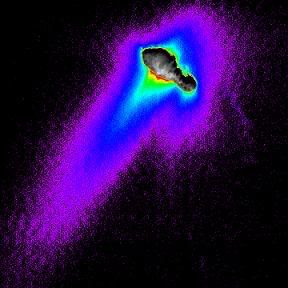Post by glactus on May 6, 2009 11:04:26 GMT

The Comet Borelly
Comets sample a very different set of compounds to that from which the Earth, Moon and Mars are made. To find out about the Solar System's water and the dust that escaped planetary formation we need to study comets.
Above is a Composite image of comet Borelly, by NASA's Deep Space 1 spacecraft. Colours show the brightness of the comet's dust and coma. Red is about one tenth the brightest of the coma while blue is about one hundreth the brightness. The sun is shining from the bottom of this image.
The Earth and other planets are a melted and metamorphosed, eroded and buried collection of rocks and metal cores which contain only faint traces of the earliest stages of the Solar System.
They tell us about the rocky and metallic compounds that condensed in the hot inner parts in the first 10 million years. Icy compounds condensed in the outer, cooler parts of the emerging Solar System.
Comets preserve these ices and dust that condensed at low temperature. Most of the icy, small planetary bodies that otherwise became comets went into forming the gas giant planets in the outer Solar System but some were ejected from the vicinity of the largest planets.

The orbit of Haley's comet 2004
Other comets were distributed to the edges of the Solar System into the Oort Cloud. A third group that formed near or beyond Neptune are associated with the Kuiper Belt. That is where Comet Wild 2 which the Stardust mission has sampled started its life.
Of these, a fraction ended up in the inner Solar System bringing water to the Earth. Without this cometary transport, life on Earth may never have had a chance to start.
Astronomers forward the very strong view that Comets, in shedding their icy cargo as they enter the temperate zone of a star where planets abound (our Solar system) are responsible for the chemical compounds that began life cycles in the oceans of the Earth, billions of years ago.
Credits: These are NASA/JPL images


